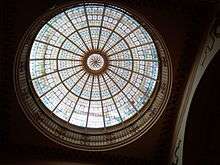Kursaal (amusement park)


The Kursaal is a Grade II listed building[1] in Southend-on-Sea, Essex, which opened in 1901 as part of one of the world's first purpose-built amusement parks.[2] The venue is noted for the main building with distinctive dome, designed by Campbell Sherrin, which has featured on a Royal Mail special edition stamp.[3]
History
The Kursaal site was opened in 1894 by father and son Alfred and Bernard Wiltshire Tollhurst on four acres of land purchased the previous year, as the 'Marine Park and Gardens'. In 1901, they opened a grand entrance pavilion, the Kursaal Palace, designed by Campbell Sherrin, containing a circus, ballroom, arcade, dining hall and billiard room. [4] The word Kursaal is German, meaning a "Cure Hall" or spa, and it seems to have been adapted to mean a place of healthy amusement. Southend's Kursaal became the largest fairground in the south of England.[5]
Football, Greyhound Racing and Music
In 1927 two Scotsmen named Jimmy Shand and Tom Wilson approached Southend United F.C., who played at the Kursaal, and agreed a deal to start greyhound racing on 27 July.[6] John Bilsland then added his name to the venture, but it only operated for two years before the entire enterprise (including greyhounds) was moved by train to the Stanley Stadium in Liverpool, due to increased rent demands.[7] The football club remained there until 1933, when they moved to Southend Stadium.
The ballroom of the Kursaal hosted all manner of musical artistes following its opening in 1901. During the 1970s it made its name as Southend's preeminent Rock music venue, showcasing Internationally successful acts such as Black Sabbath, Deep Purple, Thin Lizzy and AC/DC. A photograph of the latter performing at The Kursaal in 1977 was used on the front cover of their Let There Be Rock album.
The Kursaal as a whole had been in gradual decline since the early 1970s, with the outdoor amusements closing in 1973. At the end of 1977 the decision was made to close the ballroom, with the main building finally succumbing in 1986.
Although the outdoor amusement area was redeveloped for housing, the main Kursaal building reopened in 1998 after a multimillion-pound redevelopment, containing a bowling alley, a casino and other amusements.
List of rides and attractions
- The Skids/Swirls
- Bumper Cars
- The Morehouse Galloper 1954–1973
- Ski Jump
- Waltzer
- ROTOR
- Wild Mouse
- Calypso (Kursaal 1962–1983?-now currently travelled by John Smith)
- Cyclone (1937–1973)
- Harton Scenic Railway (1910–1973)
- Switchback Railway
- 1st Water Chute (1921–1957)
- 2nd Water Chute (1958–1971)
- Toboggan Slide (1925-
- The Mont Blanc (1933–1973)
- Laff In The Dark (1938–1973)
- Aerial Flight (1894–1973)
- Figure Eight (?-1947)
- River Caves
- Joy Wheel
- Bowl Slide
- Airsport (?-1973)
- Miniature Railway
- The Whip (1921-?)
- The Tumblers (1921-?)
- Never Stop Railway (1923-?)
- Autodrome (1927-?)
- Wall Of Death (1929-?)
- Midget Mansion (1930-?)
- Caterpillar
- Jolly Tubes (1920's-?)
- Whirlpool (?-1973)
- Dive Bomber (1950's-1959)
- Noahs Ark (1953-?)
- Ghost Train (1931-?)
- Petboats (1933-?)
- Mountain Dipper (1933-?)
- The Whirlwind Racer (1930's-?)
- Tumblebug (1938-?)
- Seaplane (1938-?)
- Stratosphere (1945-?)
- The Under & Over (?-1973)
- Knock the lady out of bed
- Kelly's house (Destroyed by fire)
References
- ↑ The Kursaal, Southend-on-sea, British Listed Buildings, accessed 18 January 2013
- ↑ http://www.echo-news.co.uk/news/5081151.Kursaal_memories_kept_alive/
- ↑ "Royal Mail's alphabetical landmark stamps". BBC News. 2011-10-11.
- ↑ http://www.theatrestrust.org.uk/resources/theatres/show/1837-kursaal-southend-on-sea
- ↑ "A Brief History of Southend". Retrieved 12 March 2013.
- ↑ Genders, Roy (1981). The Encyclopedia of Greyhound Racing. Pelham Books Ltd. ISBN 0-7207-1106-1.
- ↑ Genders, Roy (1975). The Greyhound and Racing Greyhound. Page Brothers (Norwich). ISBN 0-85020-0474.
External links
Coordinates: 51°31′59″N 0°43′29″E / 51.5331°N 0.7247°E